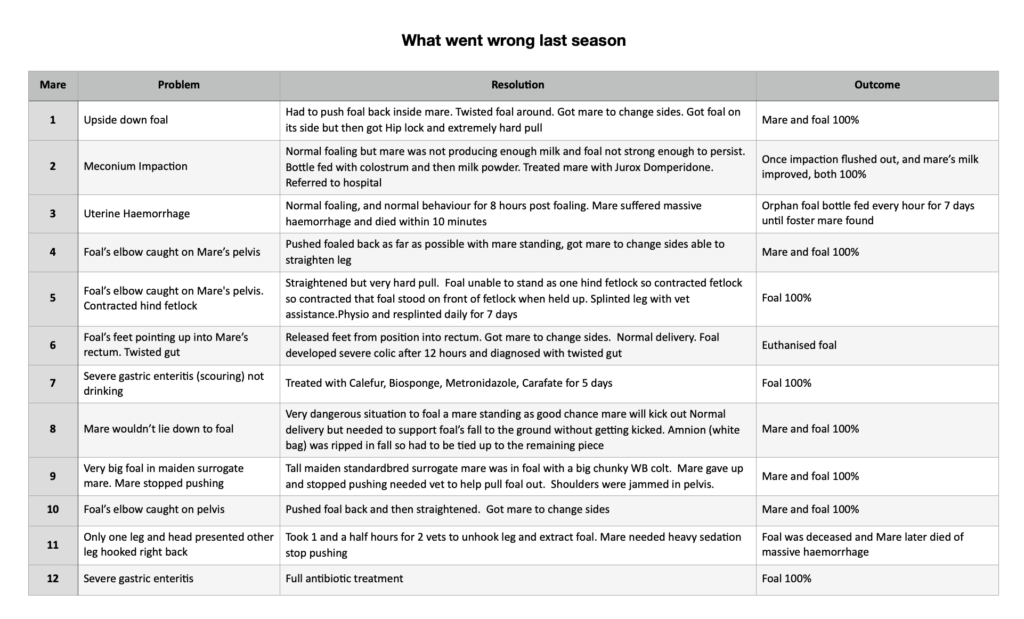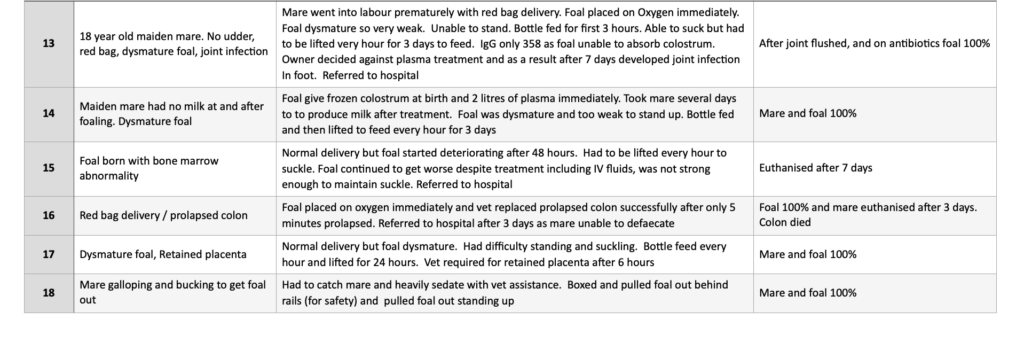
OMG there’s a foal in the paddock. How many times have you experienced this or heard this exclamation from your home breeding friends? If that mare and foal survived then you should have gone and bought a lotto ticket because you are one lucky breeder.
Hi, my name is Jo Howard and I am an Equine Midwife. No formal qualifications just years and years of experience from over 1000 foalings. I run a small sporthorse breeding stud, Bonnington Lodge in Tokoroa and offer foaling down and AI services. Last year I had a horrendous foaling season and this has prompted me to pass on my experiences to the home breeder.
My plea to any breeder is to send your broodmare to a professional for foaling. Let me share my last season’s experience to consolidate this recommendation.
From September to March, I foaled down 41 mares. Let me point out that most of the mares were sporthorses who were well looked after and arrived in good condition for foaling. Out of the 41 mares 18 had dystocia (foaling difficulty) or the foals had survival crises. Here is a summary.


All these cases required immediate intervention or assistance and also the knowledge of what to do quickly in an unnatural foaling situation or identifying what’s wrong with a sick foal. Recognising the problem and carrying out the required procedure or treatment quickly will make the difference between life and death. Of these 18 cases, 13 mares and/or foals would probably have died without immediate knowledgeable intervention, and the remaining 5, they could have been possible fatalities.
Once a mare’s waters break, you have a maximum of 20 to 30 minutes to deliver the foal. Mares and their neonate foals are fragile creatures and if left to their own devices, will not survive if they have a foaling issue.
Unless your vet is available within 20 minutes of your emergency call, do not even consider foaling your mare at home. When I need the vet, I need them now, not in 45 minutes. Our vet practice always sends two vets when I call for a foaling emergency. This gives the mare and foal the best chance of survival.
Please, do not let me put you off breeding. But consider the following:- You have paid a stud fee, vet reproductive fees, fed your mare for 11 months. Now maximise your chances of a live mare and foal after spending all this money and send your mare to a professional for foaling.
Where to go
There are a huge number of studs throughout New Zealand who will take sporthorses to foal down. There are also a number of organisations who specialize in foaling and reproductive services. It is important that a foaling facility has 24 hours surveillance as mares can foal at any time of the day. The easiest way to find the service you require is to ask friends on facebook or your vet and they will hopefully give you recommendations.
What it will cost you
Prices vary but the range is from $800 to $1200 plus GST. The cost will depend on the length of stay and is made up of a dry agistment cost per day, a foaling fee and a wet agistment cost per day. Vet, farrier, dental costs are all extra. These charges should include daily fibre and hard feed for your mare. Confinement charges can be extra.
When to send your mare
Its important that your mare is settled and happy in her foaling environment. Generally send your mare away for foaling two to three weeks prior to her foaling date. More importantly, closely monitor the mare’s udder development. As soon as the udder starts to change, contact your foaling organization and discuss transportation date. I always say, “the udder tells your everything” so get used to checking every day from 10 months onwards to monitor development. I encourage owners to start taking photos of the udder on a daily basis once changes are noticed.
How long will your mare be away
The stay will depend on your mare’s gestation length. If you send your mare away 2 weeks prior to foaling, the delivery is uneventful and the foal’s first week is problem free, then the mare and foal can return home after 7 days. It is quite safe to transport mare and foal with professional transporters or in your truck or float at this stage. The foal will just stand beside the mare and drink on the way home. Don’t try and separate as this just increases anxiety for both mare and foal.
Live Foal Guarantee
Check your stallion contract as there is probably a clause that only offers a live foal guarantee if the mare is professionally foaled down or she has an attended foaling. This attended foaling does not mean that you check the mare a couple of times during the night or putting a foaling alarm on her. Remember for most foaling alarms to work, the mare must lie in the prone position. Lots of mares try to foal in the sitting or standing position. Foaling alarms are only an aid not a guaranteed indication of foaling.
Checklist
(no foaling facility will take your mare if not strangles vaccinated)
As a horse owner, you are no doubt a confidant horseperson but don’t confuse confidence with knowledge and experience. The window between success and fatality is extremely narrow. Please give your mare the best possible opportunity to deliver a strong, healthy foal. Their future is in your hands.
Hotline number. Please contact me (Jo Howard) on FB or phone me 24/7 if you have a problem, a concern or a question. Very happy to help anyone day or night. 027 685 7717
You must be logged in to post a comment.
"*" indicates required fields